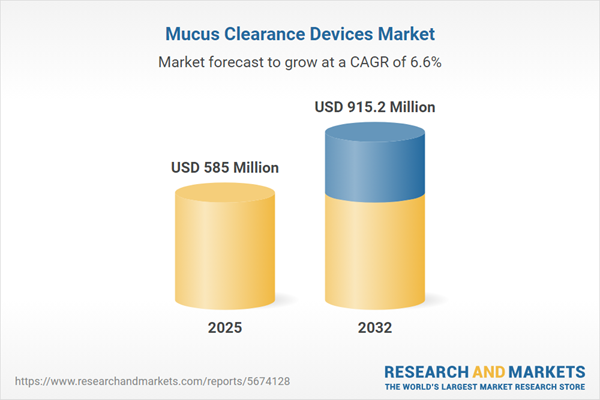Speak directly to the analyst to clarify any post sales queries you may have.
The mucus clearance devices market is evolving quickly, driven by growing adoption of noninvasive respiratory therapies and the increasing need for patient-centered solutions within integrated healthcare systems. As connected care becomes standard, senior decision-makers are focusing on operational efficiency and enhanced patient outcomes through advanced device adoption.
Mucus Clearance Devices Market Snapshot
Experiencing strong compound annual growth rates and an expanding market size, the mucus clearance devices market is shaped by escalating clinical needs for both chronic and acute pulmonary disorder management. Demand for advanced respiratory technology is promoting a climate of heightened innovation, with manufacturers refining products to meet practitioner preferences, ensure seamless digital respiratory care integration, and support compliance across evolving regulatory environments. There is dedicated emphasis on systems that offer continuous therapy from hospital settings to home care, reinforcing the goal of comprehensive patient management. Healthcare leadership is driving this shift by focusing investments on improving care quality, tracking measurable outcomes, and optimizing operational models as health delivery structures transform globally.
Scope & Segmentation in the Mucus Clearance Devices Market
- Product Types: High-frequency chest wall compression systems, intrapulmonary percussive ventilators, mechanical mucus clearance devices, and ultrasonic solutions all serve a wide range of respiratory therapy needs, supporting adaptability as clinical environments change.
- Applications: Instruments are routinely utilized to support therapies for bronchiectasis, cystic fibrosis, chronic obstructive pulmonary disease, and pneumonia, making them integral across hospitals, outpatient centers, and home care scenarios.
- End Users: Hospitals, specialist clinics, and homecare organizations benefit from devices built with an emphasis on safety and usability, enabling streamlined processes and an improved experience for healthcare teams and patients alike.
- Distribution Channels: Reliable access is ensured through well-established physical distributors as well as emerging digital procurement platforms, meeting the procurement needs of healthcare professionals, institutional buyers, and medical distributors efficiently.
- Geographic Coverage: The Americas, EMEA, and Asia-Pacific markets each present unique regulatory and infrastructure demands, making it essential for stakeholders to adopt regionally tailored strategies as reimbursement requirements evolve and healthcare delivery models adapt.
- Leading Companies: Koninklijke Philips N.V., Medtronic plc, Baxter International Inc., Smiths Medical, Electromed, PARI GmbH, Zepf Medical Inc., Drive DeVilbiss Healthcare LLC, Monaghan Medical Corporation, and Thayer Medical Corporation influence the pace of device innovation and deliver customized respiratory care solutions worldwide.
Key Takeaways for Healthcare Executives
- Integrated device platforms now align with broader healthcare technology systems, supporting patient monitoring, care transitions, and automated processes across various clinical settings.
- Advances in device materials and ergonomic design have made products more comfortable, supporting better adherence in both extended therapies and ambulatory care settings.
- Clinical IT system compatibility enables straightforward data capture and analytics, equipping leadership with relevant insights for workflow and administrative refinement.
- Manufacturers focus on accessible, portable solutions and responsive after-sales service, accelerating product adoption rates through direct training and ongoing operational support for clinical staff.
- Updated digital product standards reinforce rigorous safety and quality validation, streamlining decision-making for providers evaluating new device investments for respiratory management initiatives.
United States Trade Tariffs: Supply Chain Impact
Recent adjustments to United States trade tariffs have introduced additional complexity to global supply chains for mucus clearance devices. In response, leading companies are building more resilient distribution networks, closely managing costs, and focusing on consistent inventory levels to maintain reliable product access in primary markets. Strategic contingency planning is a priority, supporting ongoing regulatory compliance and ensuring uninterrupted product supply across regions.
Research Methodology & Data Sources
The presented analysis is informed by in-depth primary interviews with healthcare executives and clinicians, complemented by reviews of regulatory guidelines and scientific publications. Insights are validated through leading device manufacturer disclosures, resulting in up-to-date and decision-ready market perspectives.
Why This Report Matters
- Empowers healthcare executives to implement noninvasive respiratory therapies while staying ahead of evolving clinical and regulatory benchmarks in the mucus clearance devices market.
- Delivers operational guidance for compliance and growth planning, taking into account shifting reimbursement and workflow requirements across diverse care settings.
- Provides actionable insights for effective technology integration, streamlined operations, and robust regulatory support throughout international healthcare markets.
Conclusion: Strategic Directions for Market Leaders
Sustained success in mucus clearance devices hinges on agile technology integration and process optimization. Decision-makers who champion adaptability and efficient management practices are well positioned as global respiratory care continues to advance.
Additional Product Information:
- Purchase of this report includes 1 year online access with quarterly updates.
- This report can be updated on request. Please contact our Customer Experience team using the Ask a Question widget on our website.
Table of Contents
3. Executive Summary
4. Market Overview
7. Cumulative Impact of Artificial Intelligence 2025
Companies Mentioned
The companies profiled in this Mucus Clearance Devices market report include:- Koninklijke Philips N.V.
- Medtronic plc
- Baxter International Inc.
- Smiths Medical, Inc.
- Electromed, Inc.
- PARI GmbH
- Zepf Medical Inc.
- Drive DeVilbiss Healthcare, LLC
- Monaghan Medical Corporation
- Thayer Medical Corporation
Table Information
| Report Attribute | Details |
|---|---|
| No. of Pages | 199 |
| Published | October 2025 |
| Forecast Period | 2025 - 2032 |
| Estimated Market Value ( USD | $ 585 Million |
| Forecasted Market Value ( USD | $ 915.2 Million |
| Compound Annual Growth Rate | 6.5% |
| Regions Covered | Global |
| No. of Companies Mentioned | 11 |









